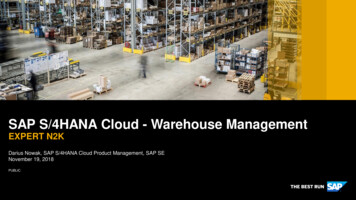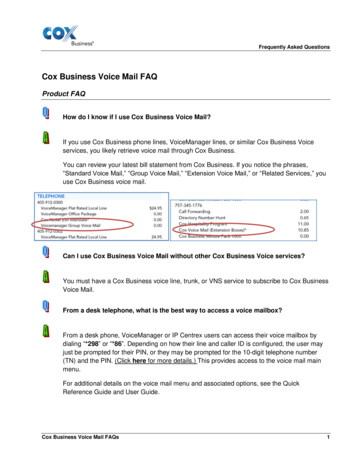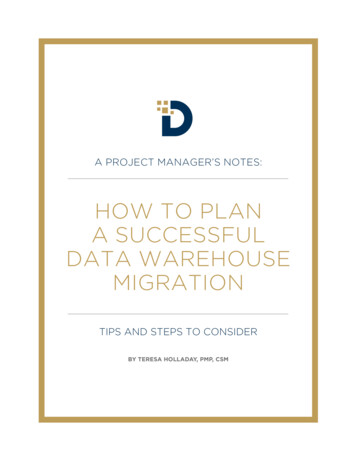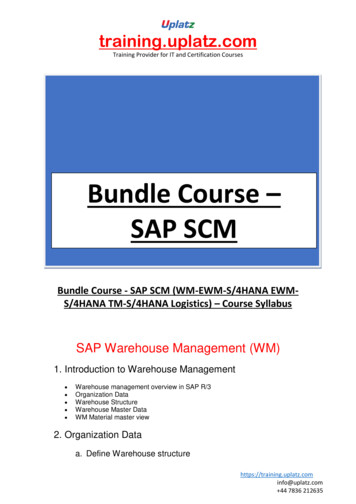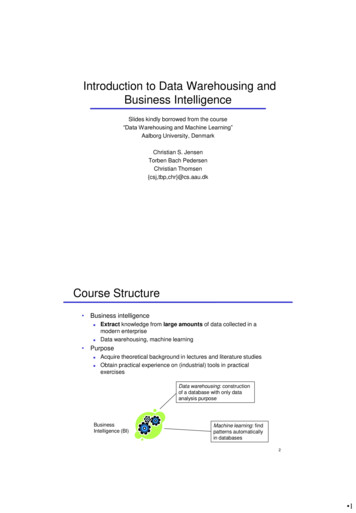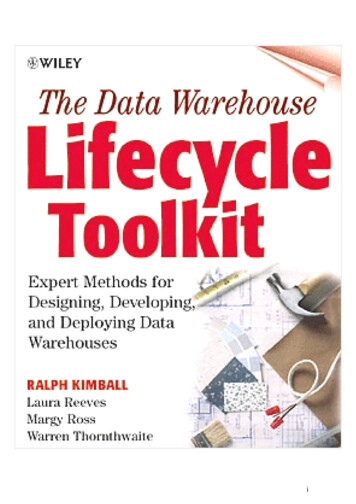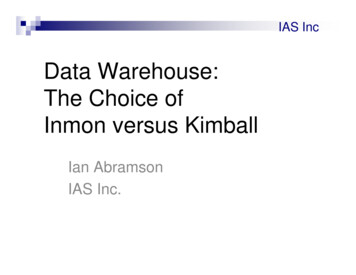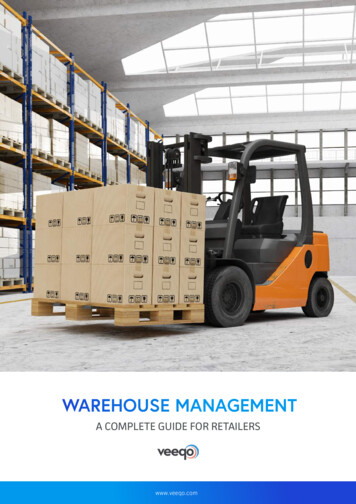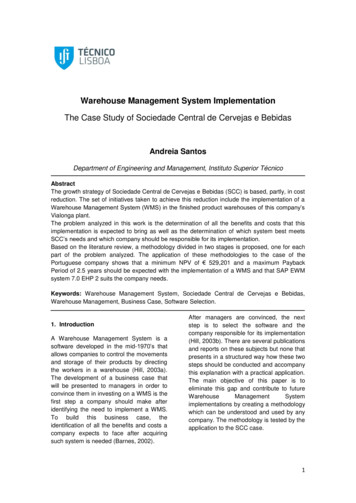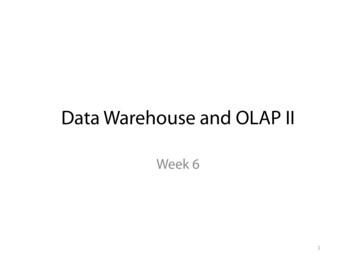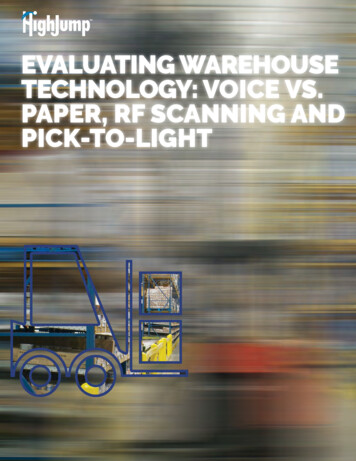
Transcription
EVALUATING WAREHOUSETECHNOLOGY: VOICE VS.PAPER, RF SCANNING ANDPICK-TO-LIGHT
Evaluating Warehouse Technology: Voice vs. Paper, RF Scanning and Pick-to-LightINTRODUCTIONWhen evaluating picking solutions for the warehouse, there are four main options that areoften considered: voice, paper, RF scanning, and pick-to-light. Although each of thesesolutions have their own strengths, weaknesses, and ideal applications, they should allbe considered when making a decision about future projects. Comparing the four solutions to each other, and evaluating what they will bring to your operation, is the bestway to determine what will be the best fit for your operation.PAPERPaper-based order picking, or label processing, is the process of completing warehouse procedures with the use of paper orders. Paper picking is typically coupled withafter-the-fact data entry using desktop terminals. Associates perform warehouse tasksoff of pick lists, put-away labels, printed VAS instructions, and other paper documents.Upstream processes (such as how the informationis sorted on the documents), and downstream processes (such as scan and verify on adesktop terminal), directly impact paper/label processing’s performance and functionality.Paper/label processing is thought of as a good fit for smaller operations with relativelystraightforward transaction requirements and minimal budgets. Even operations thatrely on RF scanning for the bulk of transactions usually employ paper/label processingfor some functions. It can be purely a manual proposition or part of an automatic flow,such as a label case pick-to-belt, where the pick is confirmed by an in-line conveyorscan. There is very little investment required with a paper picking process, with a majority of the costs associated being for paper and printer ink.Paper Picking ProcessPaper Pick nPriniorateneDistributionWarehousePersonnelManual hen an employee picks with paper (or labels), they go through the following ions printed (whether a list or sheet of labels) and picked upRead LocationNavigate to locationCheck the item to be pickedPut down the clipboard/paperPick the itemPick up the clipboard/paperCross the item off the pick list (if picking with labels, the label goes on the productrather than crossing it off)Report back to data entry, where data is transferred manually back into the WMS2
Evaluating Warehouse Technology: Voice vs. Paper, RF Scanning and Pick-to-LightRF SCANNINGRF scanning terminals have long been considered a prerequisite for larger, more complexoperations. However, RF scanning can be found in all different types and sizes of operationsprimarily due to direct support by most warehouse management systems (WMS). Evenoperations running non-RF enabled legacy fulfillment systems can turn to automated datacollection software for this functionality.RF scanning offers some distinct advantages over paper/label processing. It can providepositive verification that the warehouse associate is at the right location or picked thecorrect SKU through a barcode scan or key entry. Work can be pushed out to associatesbased on location and task priority instead of handed out from a manually managedqueue. Transaction data is captured in real time as associates perform tasks. Furthermore, RFscanning makes some functions like multi-order cart selection possible or more practical thanpaper/label processing.RF Picking ProcessPut awaydevicePick updeviceCONFIRM PICKREAD PICKQUANTITYPICK ITEMSSCAN LOCATIONREAD LOCATIONWhen an employee picks with RF scanning, they go through the following process:1.2.3.4.5.6.7.8.9.Read the location on the scannerNavigate to locationScan location labelRead pick quantity on screenScan label on productPut down the scannerPick the itemPick up the scannerDevice uploads data back into the WMSPICK-TO-LIGHT (PTL)Pick-to-Light remains a popular selection technology due to its ability to support high pickrates and its ease-of-use. It is typically used in a zone-based, pick and pass flow where anassociate scans a tote or carton barcode label. The PTL software activates light displaysfor every location that shows the required quantity needed for the tote or carton. Theassociate walks the zone, selecting SKUs and confirming picks by pressing display buttons.Displays can also be provided to show SKU, order, or other relevant information, with somevendors even using LCD displays to show SKU pictures.www.highjump.com3
Evaluating Warehouse Technology: Voice vs. Paper, RF Scanning and Pick-to-LightAlso, as its name implies, PTL technology is about the orderselection process. Unlike the other technologies discussed inthis paper, it is not employed to drive other warehousing functionssuch as receiving, put-away, and cycle counting. This meansany investment in the technology cannot be leveraged beyondthe confines of the PTL module and order selection process.PTL is often utilized by operations who have a set number ofSKU’s with a high pick volume, as there is a considerable costassociated with adding each new SKU. The process used fora PTL picker is easy to follow and learn, and can lead to largeincreases in productivity.PTL Picking ProcessWhen an employee picks with PTL, they go through the following process:1.2.3.4.5.6.7.Workers are assigned zonesNavigate to zoneScan tote or carton labelLight mounted above product location illuminatesRead the quantity neededPick productClick on the light to confirm pickvoice system is directly connected to your WMS or ERP, allowinglive updates to be transmitted as workers are on the warehousefloor. This not only helps with inventory management, but alsoallows supervisors to stay up to date with productivity of theirworkers on an individual level.Voice Picking ProcessWhen an employee picks with voice, they go through thefollowing process:1.2.3.4.5.6.Hear the location while navigating to itReach the locationSpeak the check digits located at the siteListen to the number of items to be pickedPick the itemsVerbally confirm the quantityIt should be noted that on step six, the picker has the option torelay any issue at the pick site, whether it be a short or a damageditem, back to the WMS. For example, if there is a short, the pickerwould only report the number they were able to pick. The voicesystem would ask them to confirm that their mispick was due toa short, and then the picker could move on from that location.Here is an example of what the voice interaction would look likein that case:VOICEVoice technology for use in the distribution center was createdwith one purpose in mind: maximizing operational efficiencyin the warehouse. Most other warehouse technologies requireworkers to transfer their attention from the task at hand to apiece of paper, screen, or light and back, taking time andincreasing the likelihood of error. With voice, workers arehands-free and eyes-free, with the voice system feeding theirinstructions through a headset. This allows them to work quicklyand efficiently, increasing productivity and accuracy throughoutyour warehouse. Many warehouses will also experience a largedecrease in training time, as voice training can take as little asan hour.Voice is typically used to support tasks such as order selection,put-away, replenishment and cycle counting within the warehouse,but it can be deployed into many other areas as well. Theexpansion into other workflows is aided by the fact that thewww.highjump.comVoice system: “Pick four.”Picker: “Three”Voice system: “You said three, I asked for four. Is this a short?”Picker: “Yes”Voice vs. Paper PickingWhile paper picking is a great starting point for many smalleroperations, it tends to be a barrier to large scale growth andimprovement. Paper completely eliminates the ability forreal-time visibility into inventory, employees, or systems. Theentire process is held until the data entry process begins, andthat process is prone to errors. The process is also reliant on theprinters remaining functional, as any maintenance issues canbring an operation to a standstill.4
Evaluating Warehouse Technology: Voice vs. Paper, RF Scanning and Pick-to-LightAdditionally, having workers burdened with paper handlingslows down the processes that are key to the functioning ofyour DC. Having to pick up and put down clipboards removesthe workers attention from the task, and can lead to unwantederrors or mispicks. This problem is also added to as many workerswill attempt to memorize several steps ahead to increaseproductivity, leading to mix ups, mispicks, and inventory issues.Voice advantages over paper:nnSupervisors have real time visibility into what ishappening on the warehouse floornnLive updates on inventory, shorts, and damages into theWMS/ERP systemnnHands and eyes freennIncreased productivity, safety and accuracynnCuts down on operational costs associated with paperand inknnGreener solutionVoice vs. RF ScanningPrior to voice, no other technology had a greater impact on theevolution of WMS than mobile or RF scanners. While they arepopular with many companies, RF and barcode scanners dohave some drawbacks. Training on RF scanners can be extensive,with some operations requiring up to three weeks before workersare self-sufficient. Once fully trained, these workers are still distracted with something in their hands, and are unable to completewarehouse processes without picking up and putting down thescanner.Additionally, maintenance costs for the devices can be high,as many workers drop or mishandle the scanners during use.This can lead to expensive screen or keyboard replacements,as well as the need for extra equipment to compensate for thedamaged units.Voice technology allows workers to complete tasks quickly andefficiently, with workers able to keep their hands and eyes free,and their attention on the project at hand. The voice pickingprocess can shorten the information exchange between thepicker and the system, which leads to a direct increase in pickingspeeds and productivity.www.highjump.comVoice advantages over RF scanning:nnHands and eyes freennNo struggling to read a screennnSafer picking with a reduced drop/damage ratenn25% more productive on averagennDecreased training time- most voice users are up to speedin a few hoursnn40% more accurate on averageVoice vs. PTL PickingPick-to-light presents challenges that go beyond pick rates andraw productivity numbers. It is an inherently more costly andcomplex technology that typically requires a significantlyhigher start-up investment and a relatively rigid product flow.Each new SKU requires its own light system, meaning that anyadditional products added to your operation will have a significantcost associated with it. There is also a significant maintenance costassociated with PTL, as there are so many system parts thatcan fail (buttons, lights, displays, connectors, power supplies,wiring). All of these pieces require a back-up inventory to ensurea functional system at all times. Should an individual light goout, it may not be caught right away, as workers will just assumethat the product is not being ordered. This will be discoveredfar down the line, when there are multiple incomplete orderslogged on the same day.With PTL, totes and cartons are generally routed between fixedpick zones via a conveyor system. Managing workflow can be anongoing issue, because of daily workload fluctuations betweenzones and picker productivity that result in bottlenecks insome areas and under-utilization in others.Voice offers much more flexibility to redeploy resources tomatch daily changes in overall workload on the warehousefloor. Furthermore, changing the configuration of a pick-to-lightmodule can require additional changes to the light displays,communications backbone, and pick-to-light software as wellas physical storage media and WMS changes. Reconfiguring pickmodules supported by voice is a much simpler proposition thatgenerally only requires labeling in addition to storage media andWMS changes. Additionally, expansion with PTL can be costly,with so many pieces needing to be purchased and changed.With voice, costs are driven by number of users rather thanSKU’s, helping minimize operational costs.5
Evaluating Warehouse Technology: Voice vs. Paper, RF Scanning and Pick-to-LightAdding new products?Add SKUs foreach productBuy equipment andmodify software foreach SKUInvest more moneyVoice advantages over PTL:nnHands and eyes free- no need to look for lights, read displays, or press buttonsnnIncreased flexibility and less costly expansionnnReduction in bottlenecksnnAdaptable for other warehouse activities like receiving, cycle counting, replenishment, loading and put-awaynnAbility to track individual worker performancennCost per worker rather than per SKUCONCLUSIONAlthough each of these solutions has its merits, voice often out-performs the other options. With better productivity, accuracy, trainingtime, and flexibility, voice has proven success in taking operations to their peak efficiency. If you have any questions about voice, orwould like to consider voice for your operation, please contact us at info@highjump.com or visit our website at www.highjump.com.ABOUT HIGHJUMPHighJump is a global provider of supply chainmanagement software that streamlines the flowof inventory and information from supplier to storeshelf. Named to the Inc. 5000 Fastest GrowingCompanies list for 3 years running, HighJumpemploys more than 440 team members worldwide,and supports more than 4,000 customers in 66countries, ranging from SME business to globalenterprises.HighJump’s functionally rich and highly adaptableend-to-end solutions help users achieve newlevels of supply chain responsiveness, performanceand profitability, from the warehouse to thestorefront, from the desktop to the driver’s cab.HighJump’s suite of warehousing, manufacturing,transportation, distribution, mobile delivery andretail solutions allow users to seamlessly drivegrowth, customer satisfaction and revenue bydelivering goods faster and more profitably.THE HIGHJUMP TEAM IS HERE TO HELP!If you have any questions regarding HighJump or how our products can improveyour business, our passionate team is here for you.Call us today at 800.328.3271. or email info@highjump.comHighJump: supply chain accelerated.www.highjump.com 2018 HighJump. All rights reserved. HighJump is a trademark of HighJump Software, Inc.
Warehouse Management System (WMS/ERP/DB) Warehouse Personnel. Evaluating Warehouse Technology: Voice vs. Paper, RF canning and Pick-to-Light www.highjump.com 3 RF SCANNING RF scanning terminals have long been considered a prerequisite for larger, more complex operations. However, RF scan

